Abstract
Based on results of a functional analysis indicating that the self-injurious behavior (SIB) of 3 individuals was maintained by negative reinforcement (escape from instructional situations), the effects of stimulus (instructional) fading were evaluated in a multiple baseline design across subjects. The rate of instructions was reduced to zero at the beginning of treatment and was gradually increased (faded in) across sessions as long as SIB remained low. However, if SIB remained high for 10 consecutive sessions, extinction was implemented until SIB decreased, at which point extinction was withdrawn and fading was resumed. Treatment was completed when the rate of instructions was the same as in baseline (two per minute), and SIB remained below 0.5 responses per minute for two consecutive sessions. Results showed that instructional fading (without extinction) virtually eliminated SIB initially, but these effects were not maintained. All 3 subjects required multiple exposures to extinction and over 150 treatment sessions in order to meet the end-of-treatment criteria. Advantages and limitations of fading procedures without an extinction component, as well as extensions of both interventions to other clinical problems, are discussed.
Full text
PDF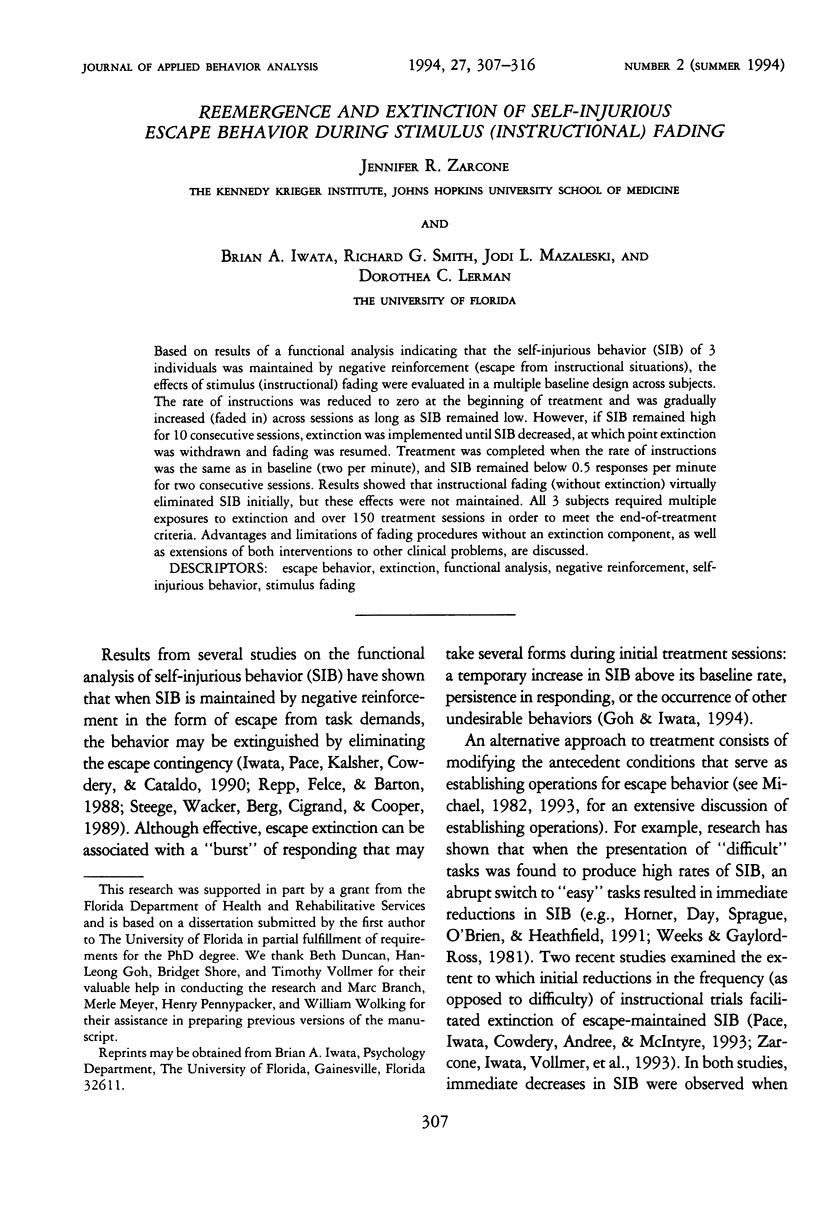
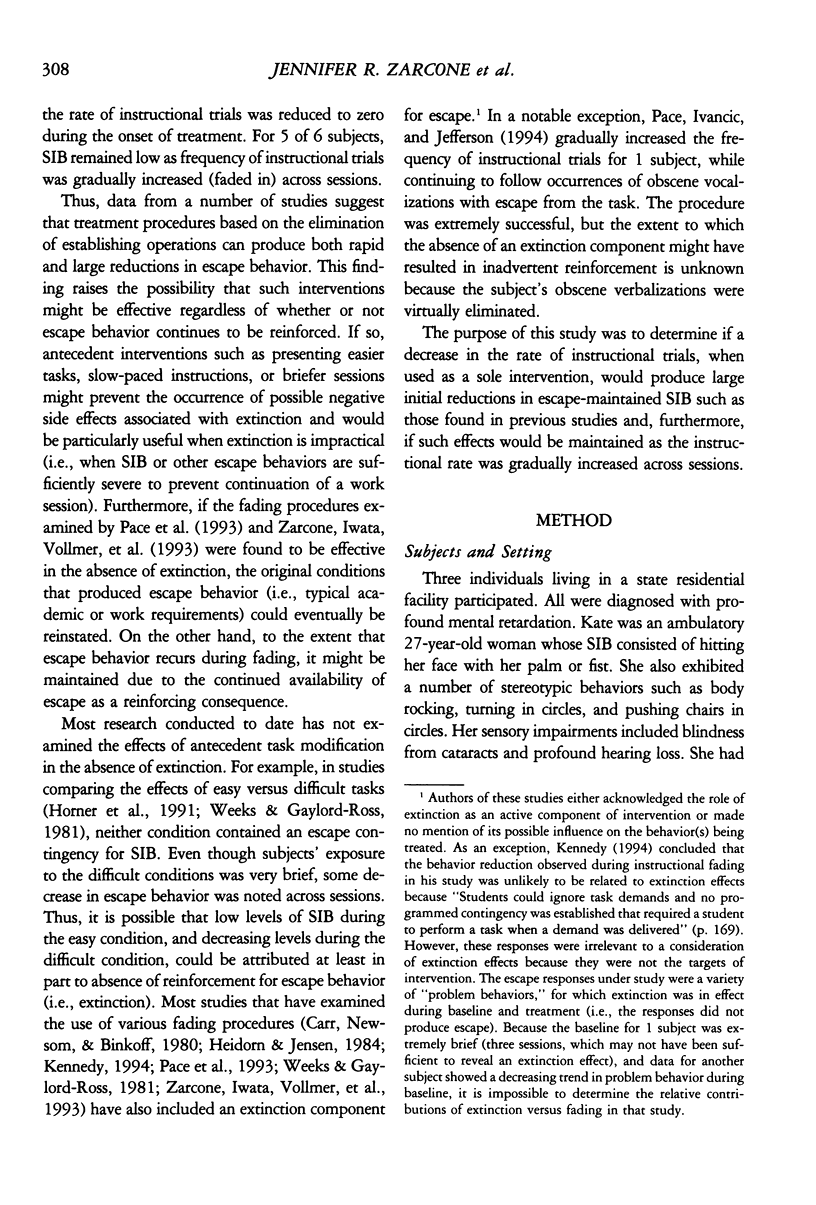
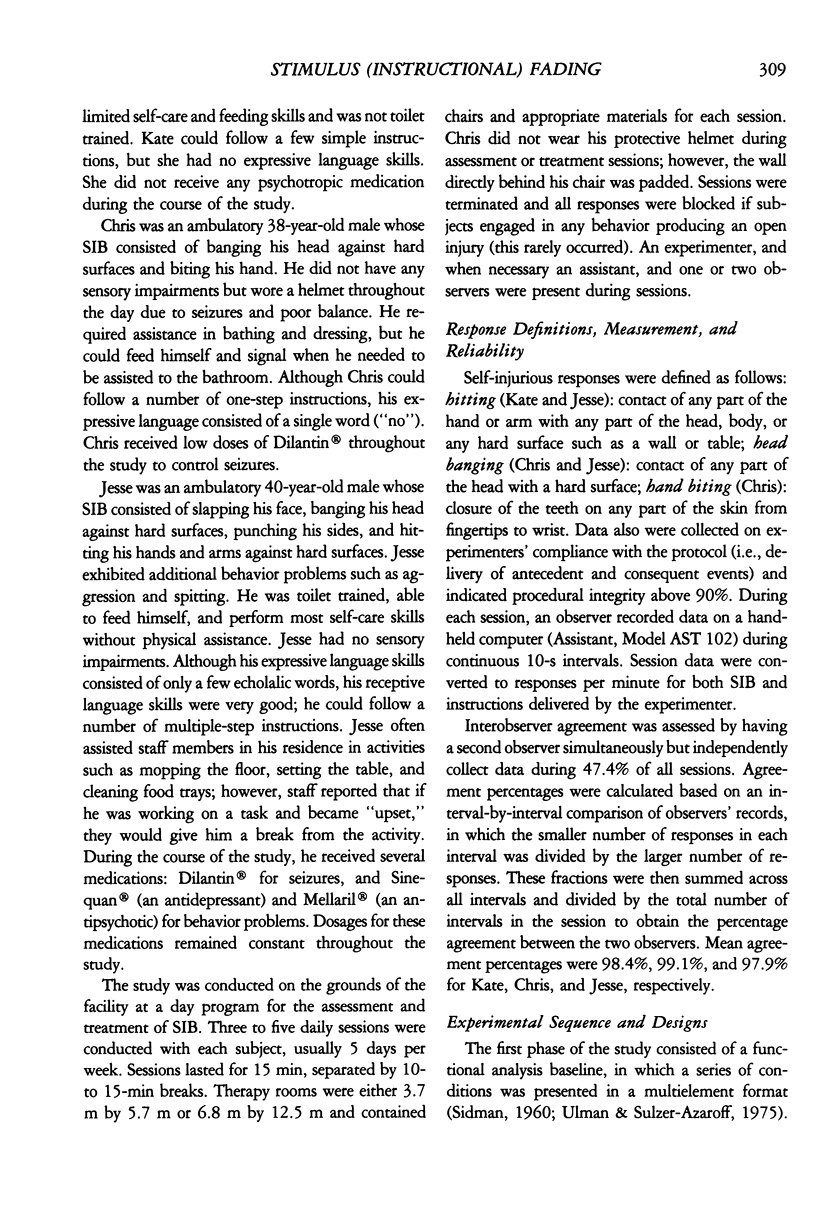

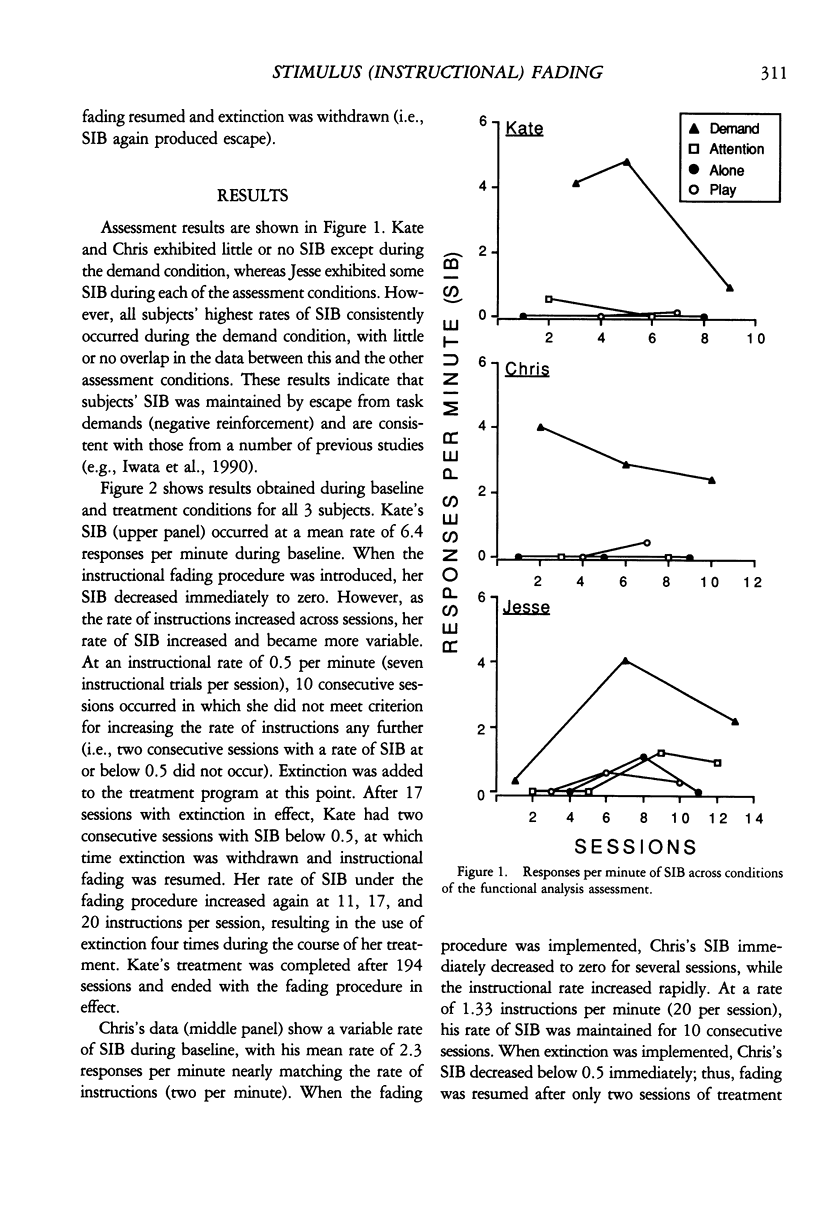
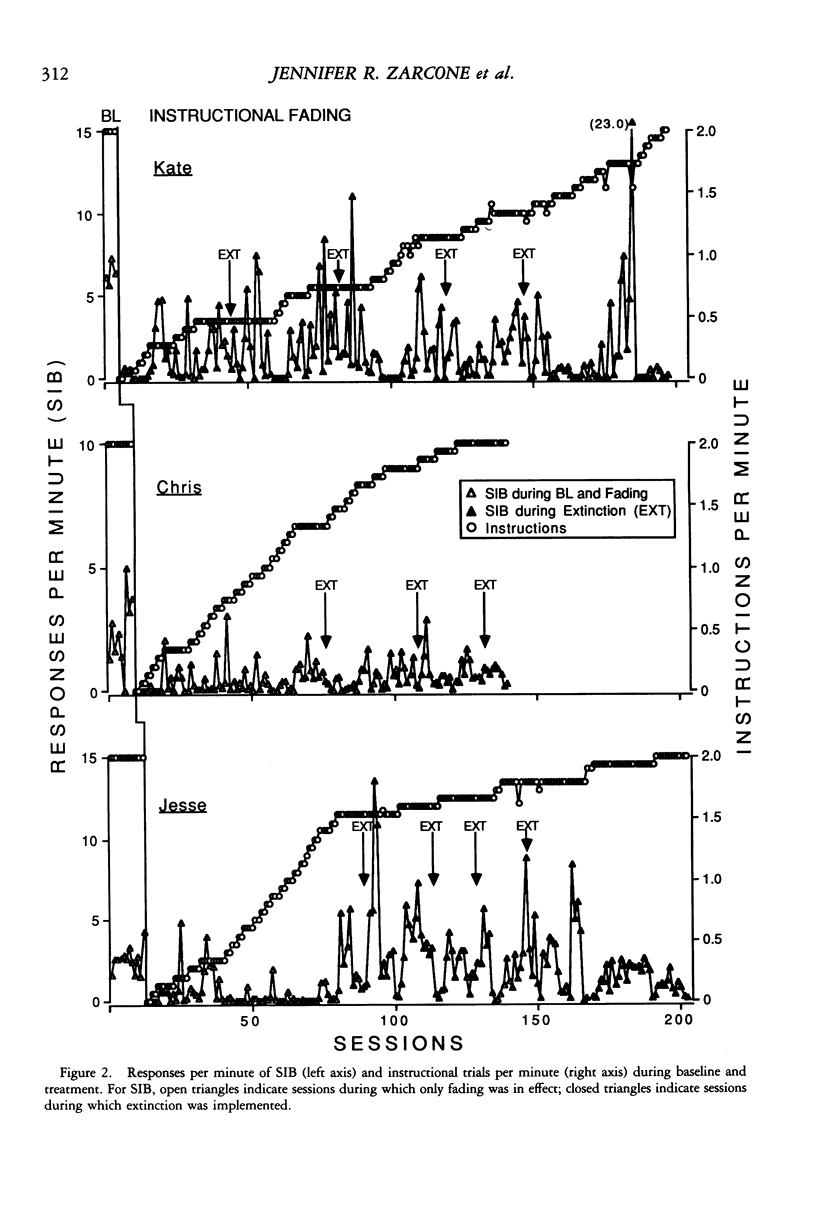

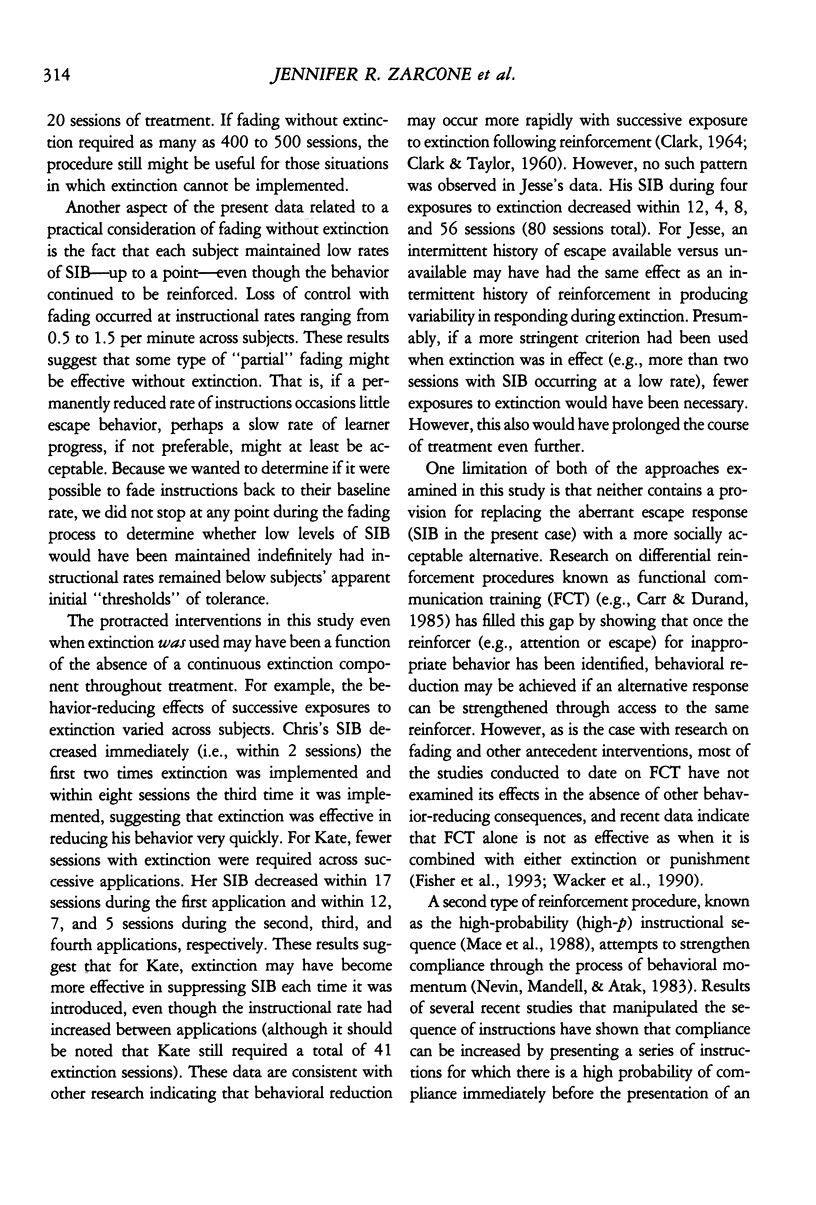
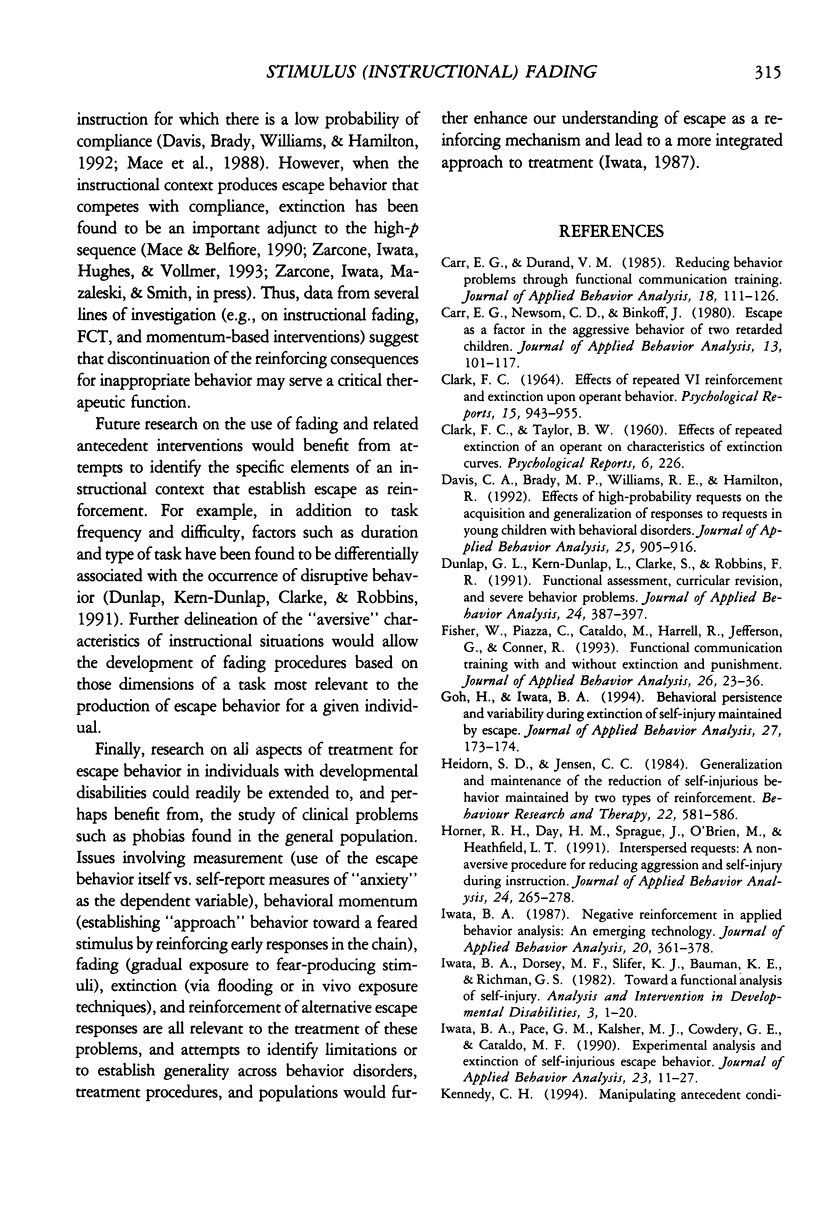
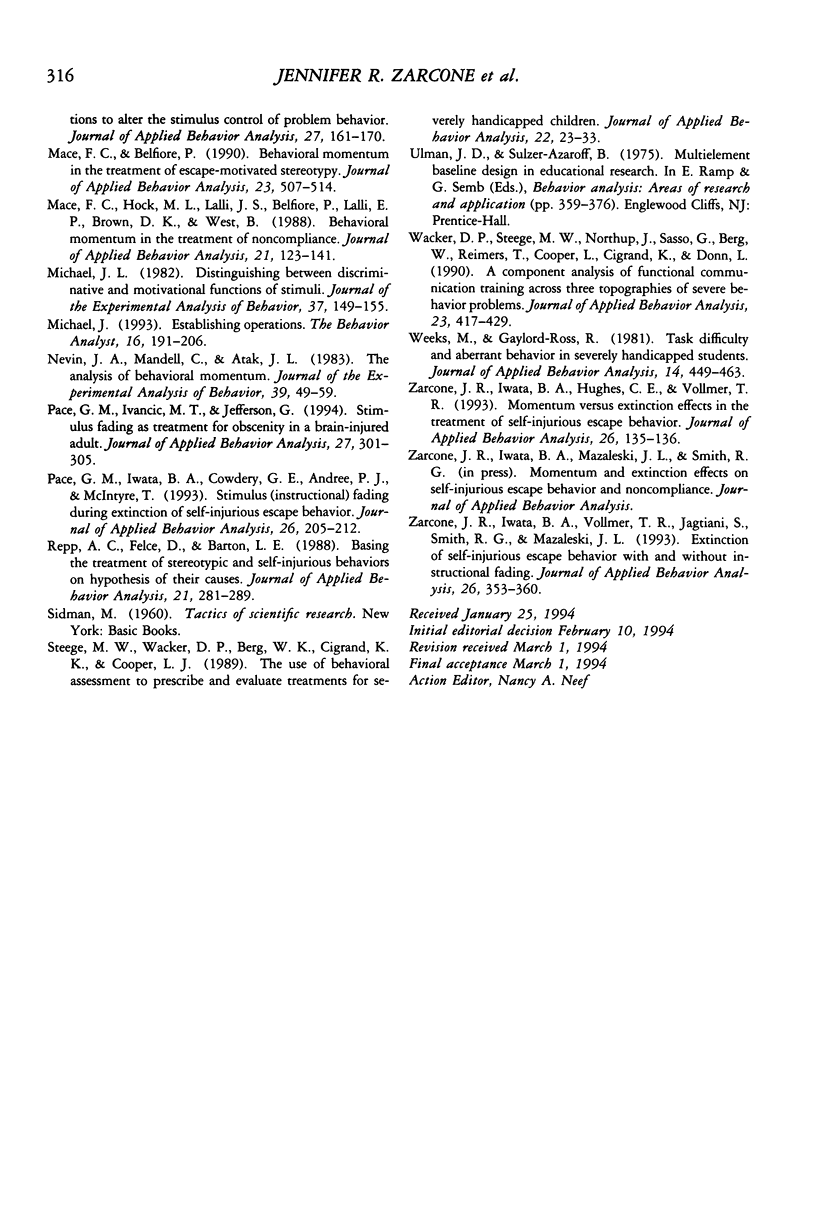
Selected References
These references are in PubMed. This may not be the complete list of references from this article.
- Carr E. G., Durand V. M. Reducing behavior problems through functional communication training. J Appl Behav Anal. 1985 Summer;18(2):111–126. doi: 10.1901/jaba.1985.18-111. [DOI] [PMC free article] [PubMed] [Google Scholar]
- Carr E. G., Newsom C. D., Binkoff J. A. Escape as a factor in the aggressive behavior of two retarded children. J Appl Behav Anal. 1980 Spring;13(1):101–117. doi: 10.1901/jaba.1980.13-101. [DOI] [PMC free article] [PubMed] [Google Scholar]
- Davis C. A., Brady M. P., Williams R. E., Hamilton R. Effects of high-probability requests on the acquisition and generalization of responses to requests in young children with behavior disorders. J Appl Behav Anal. 1992 Winter;25(4):905–916. doi: 10.1901/jaba.1992.25-905. [DOI] [PMC free article] [PubMed] [Google Scholar]
- Dunlap G., Kern-Dunlap L., Clarke S., Robbins F. R. Functional assessment, curricular revision, and severe behavior problems. J Appl Behav Anal. 1991 Summer;24(2):387–397. doi: 10.1901/jaba.1991.24-387. [DOI] [PMC free article] [PubMed] [Google Scholar]
- Fisher W., Piazza C., Cataldo M., Harrell R., Jefferson G., Conner R. Functional communication training with and without extinction and punishment. J Appl Behav Anal. 1993 Spring;26(1):23–36. doi: 10.1901/jaba.1993.26-23. [DOI] [PMC free article] [PubMed] [Google Scholar]
- Goh H. L., Iwata B. A. Behavioral persistence and variability during extinction of self-injury maintained by escape. J Appl Behav Anal. 1994 Spring;27(1):173–174. doi: 10.1901/jaba.1994.27-173. [DOI] [PMC free article] [PubMed] [Google Scholar]
- Heidorn S. D., Jensen C. C. Generalization and maintenance of the reduction of self-injurious behavior maintained by two types of reinforcement. Behav Res Ther. 1984;22(5):581–586. doi: 10.1016/0005-7967(84)90062-7. [DOI] [PubMed] [Google Scholar]
- Horner R. H., Day H. M., Sprague J. R., O'Brien M., Heathfield L. T. Interspersed requests: a nonaversive procedure for reducing aggression and self-injury during instruction. J Appl Behav Anal. 1991 Summer;24(2):265–278. doi: 10.1901/jaba.1991.24-265. [DOI] [PMC free article] [PubMed] [Google Scholar]
- Iwata B. A. Negative reinforcement in applied behavior analysis: an emerging technology. J Appl Behav Anal. 1987 Winter;20(4):361–378. doi: 10.1901/jaba.1987.20-361. [DOI] [PMC free article] [PubMed] [Google Scholar]
- Iwata B. A., Pace G. M., Kalsher M. J., Cowdery G. E., Cataldo M. F. Experimental analysis and extinction of self-injurious escape behavior. J Appl Behav Anal. 1990 Spring;23(1):11–27. doi: 10.1901/jaba.1990.23-11. [DOI] [PMC free article] [PubMed] [Google Scholar]
- Mace F. C., Belfiore P. Behavioral momentum in the treatment of escape-motivated stereotypy. J Appl Behav Anal. 1990 Winter;23(4):507–514. doi: 10.1901/jaba.1990.23-507. [DOI] [PMC free article] [PubMed] [Google Scholar]
- Mace F. C., Hock M. L., Lalli J. S., West B. J., Belfiore P., Pinter E., Brown D. K. Behavioral momentum in the treatment of noncompliance. J Appl Behav Anal. 1988 Summer;21(2):123–141. doi: 10.1901/jaba.1988.21-123. [DOI] [PMC free article] [PubMed] [Google Scholar]
- Michael J. Distinguishing between discriminative and motivational functions of stimuli. J Exp Anal Behav. 1982 Jan;37(1):149–155. doi: 10.1901/jeab.1982.37-149. [DOI] [PMC free article] [PubMed] [Google Scholar]
- Nevin J. A., Mandell C., Atak J. R. The analysis of behavioral momentum. J Exp Anal Behav. 1983 Jan;39(1):49–59. doi: 10.1901/jeab.1983.39-49. [DOI] [PMC free article] [PubMed] [Google Scholar]
- Pace G. M., Ivancic M. T., jefferson G. Stimulus fading as treatment for obscenity in a brain-injured adult. J Appl Behav Anal. 1994 Summer;27(2):301–305. doi: 10.1901/jaba.1994.27-301. [DOI] [PMC free article] [PubMed] [Google Scholar]
- Pace G. M., Iwata B. A., Cowdery G. E., Andree P. J., McIntyre T. Stimulus (instructional) fading during extinction of self-injurious escape behavior. J Appl Behav Anal. 1993 Summer;26(2):205–212. doi: 10.1901/jaba.1993.26-205. [DOI] [PMC free article] [PubMed] [Google Scholar]
- Repp A. C., Felce D., Barton L. E. Basing the treatment of stereotypic and self-injurious behaviors on hypotheses of their causes. J Appl Behav Anal. 1988 Fall;21(3):281–289. doi: 10.1901/jaba.1988.21-281. [DOI] [PMC free article] [PubMed] [Google Scholar]
- Steege M. W., Wacker D. P., Berg W. K., Cigrand K. K., Cooper L. J. The use of behavioral assessment to prescribe and evaluate treatments for severely handicapped children. J Appl Behav Anal. 1989 Spring;22(1):23–33. doi: 10.1901/jaba.1989.22-23. [DOI] [PMC free article] [PubMed] [Google Scholar]
- Wacker D. P., Steege M. W., Northup J., Sasso G., Berg W., Reimers T., Cooper L., Cigrand K., Donn L. A component analysis of functional communication training across three topographies of severe behavior problems. J Appl Behav Anal. 1990 Winter;23(4):417–429. doi: 10.1901/jaba.1990.23-417. [DOI] [PMC free article] [PubMed] [Google Scholar]
- Weeks M., Gaylord-Ross R. Task difficulty and aberrant behavior in severely handicapped students. J Appl Behav Anal. 1981 Winter;14(4):449–463. doi: 10.1901/jaba.1981.14-449. [DOI] [PMC free article] [PubMed] [Google Scholar]
- Zarcone J. R., Iwata B. A., Hughes C. E., Vollmer T. R. Momentum versus extinction effects in the treatment of self-injurious escape behavior. J Appl Behav Anal. 1993 Spring;26(1):135–136. doi: 10.1901/jaba.1993.26-135. [DOI] [PMC free article] [PubMed] [Google Scholar]
- Zarcone J. R., Iwata B. A., Vollmer T. R., Jagtiani S., Smith R. G., Mazaleski J. L. Extinction of self-injurious escape behavior with and without instructional fading. J Appl Behav Anal. 1993 Fall;26(3):353–360. doi: 10.1901/jaba.1993.26-353. [DOI] [PMC free article] [PubMed] [Google Scholar]


